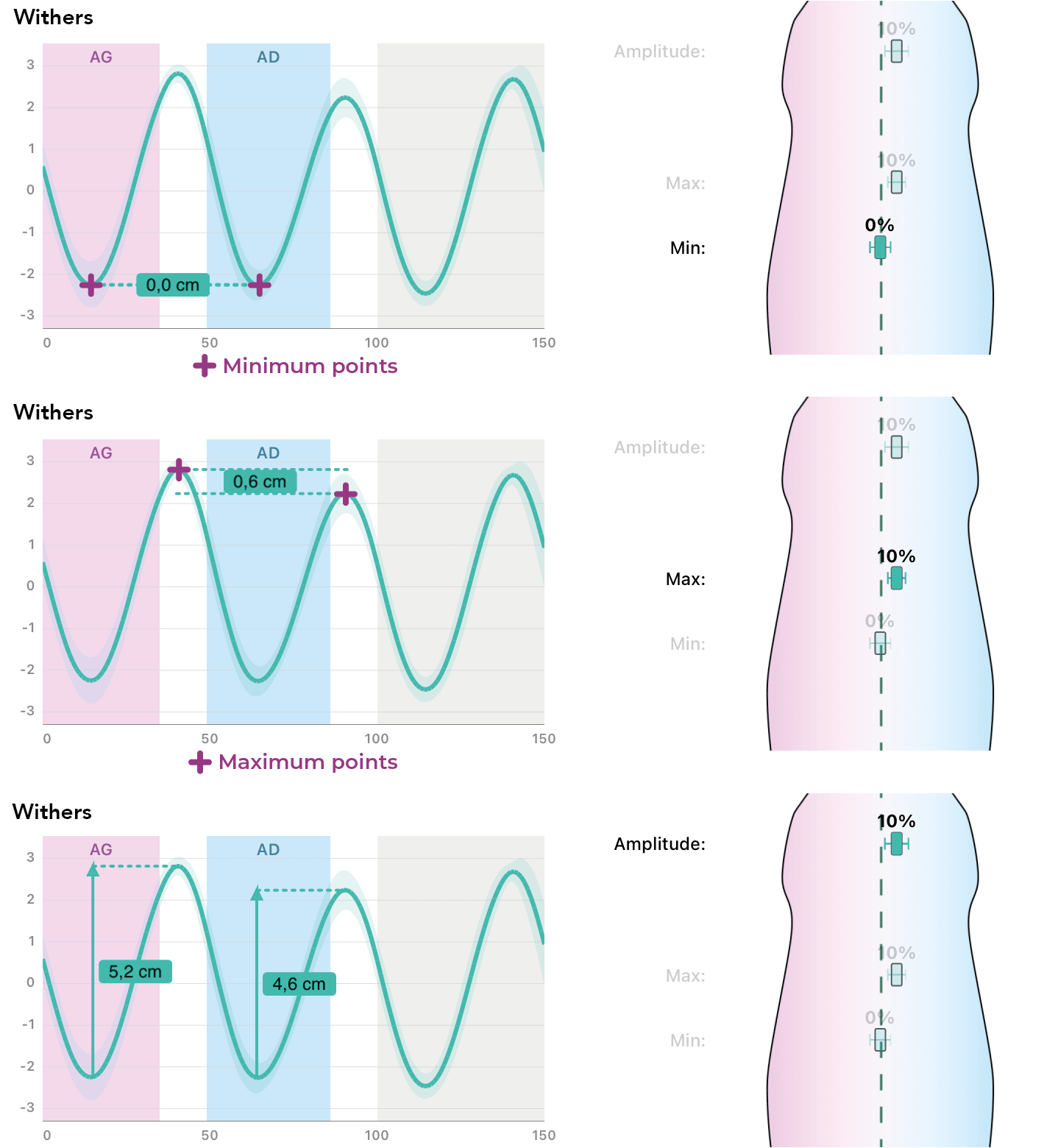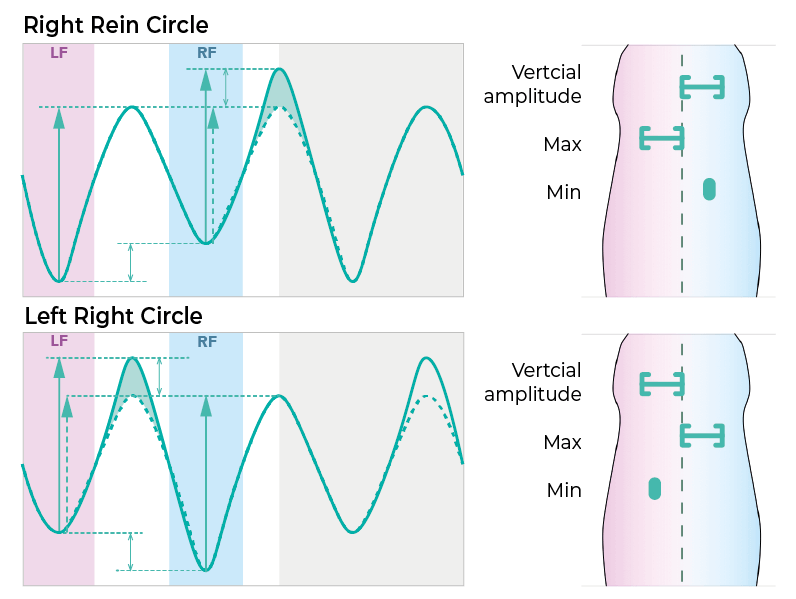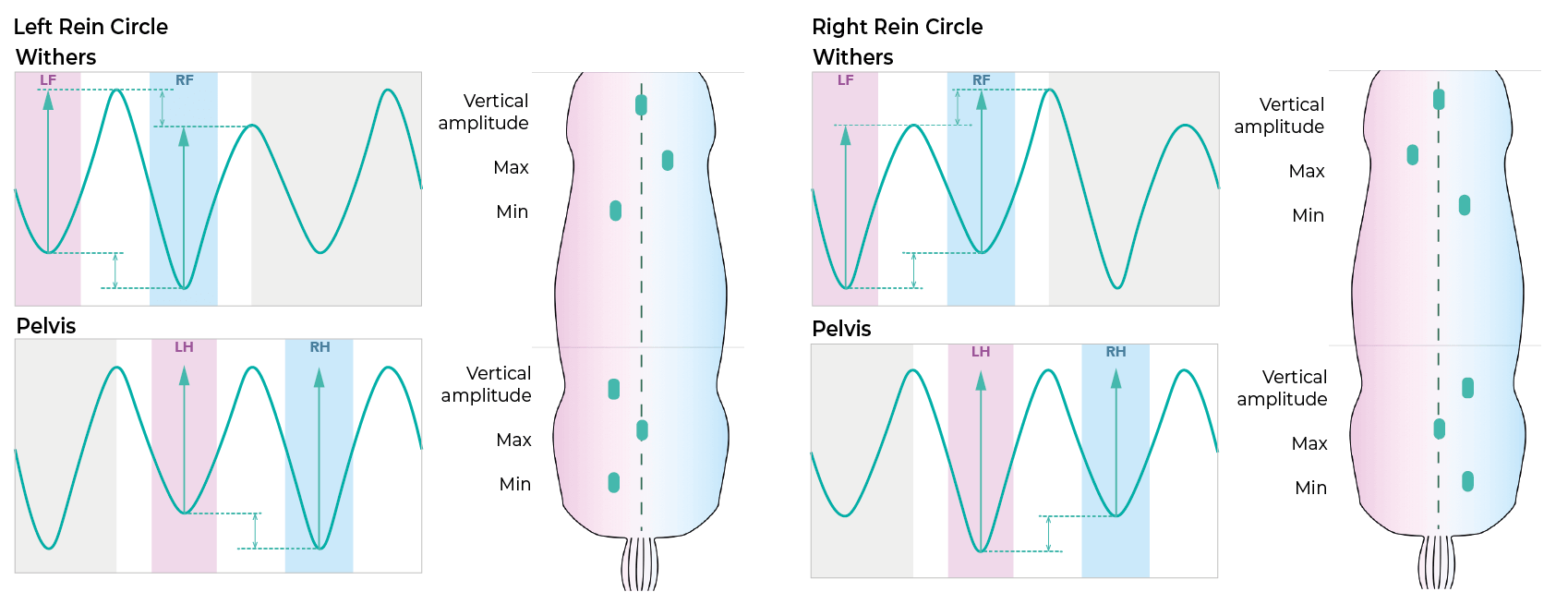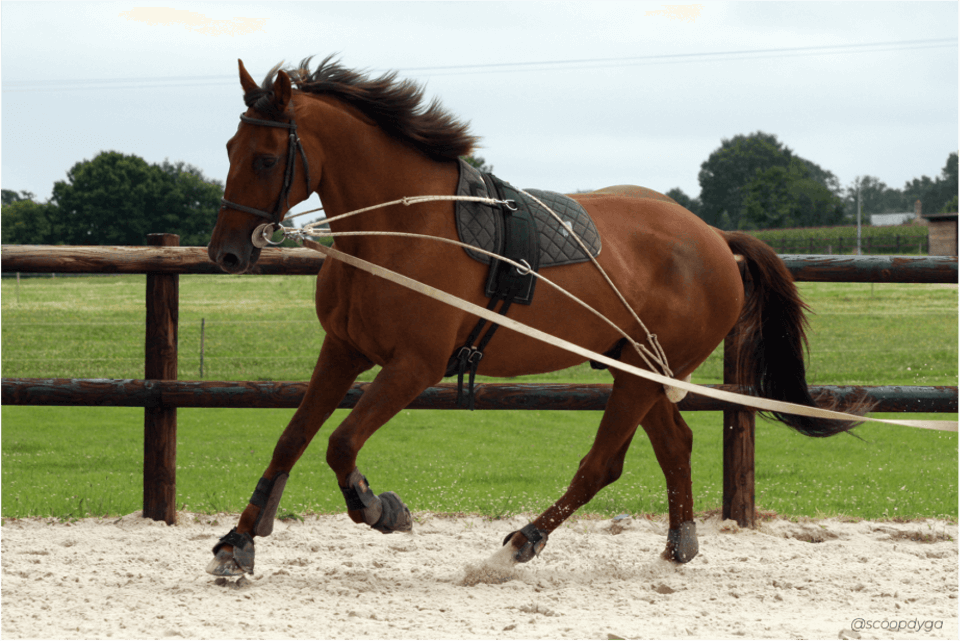The circle induces many transformations in the horse’s locomotion. However, this figure is widely used in the daily work of the horse, but also in the evaluation of its movement. In this article, discover what are the main elements highlighted by scientific studies regarding the circle’s impact on the horse’s locomotor system and why and how to analyse this figure. The last part is an introduction to circle analysis with EQUISYM, a locomotion quantification tool.
What effect does the circle have on locomotion?
When a horse moves in a circle, its body inclines and changes happen. Because the circle is a complex figure, the variations in movement are more significant than in a straight line. Clayton and Sha (2010) detected changes in trunk orientation and limb weight during circle movement compared to straight line movement. As the speed and radius of the curve increases, the angle of inclination also increases, and this impacts the asymmetry of the gait.

It was found that the gait (walk, trot, canter) resulted in greater changes than the type of exercise (straight, circular). Trot frequently showed smaller average changes than the other gaits, suggesting that it is a more dynamically stable gait, which may allow horses to adapt more easily to circular exercises.

At this gait (trot), studies have shown that the vertical movements of the head and pelvis during lunging are more asymmetric than during straight line trotting.
The common asymmetrical head patterns observed are more upward movement during propulsion of the outer forelimb and less downward movement during stance of the inner limb. The most common asymmetric movement of the pelvis is less upward movement during propulsion of the outer hind limb and less downward movement of the pelvis during stance of the inner hind limb. However, a perfect symmetry between the right and left hand should not be expected.

The most constant observation related to the hind limbs during the lunging is a lower pelvis movement (RHmin) during the inner hind limb bearing phase, imitating inner hind limb lameness, frequently in both reins. Frequently, horses also present a lesser upward movement of the pelvis after the outer hind limb bearing phase. (Rhodin and al. 2015)
The scientists (Greve, Dyson, Hobbs) have also observed that the level of training can have an impact on the angle of inclination, as a horse that is trained and used to circling can move more vertically than a horse that is not. This has been particularly observed in dressage, where older, trained horses are able to move by engaging the musculature of their neck, back and hindquarters, whereas a younger horse would not be able to do this in circles.
More broadly, various scientific studies could provide the following:
-
-
- Kinetic asymmetries have been observed in horses during lunging (Chateau and al. 2013).
- One possible explanation for the greater variation is that horses have more freedom to alter their own speed, circle diameter, and body direction on the lunge (Hardeman and al. 2019).
- Speed, ground type, and circle radius affect the symmetry of movement (Pfau and al. 2012).
- larger angle of inclination at higher speeds could be the source of greater outer limb push, and thus greater average surface area loaded into the outer limb at the canter (Hobbs and al. 2011).
- Body inclination can also increase when a lame forelimb is on the inner side of the circle (Greve and al. 2016).
- During circle exercises, unequal vertical forces can be imposed on the joints and bones of the limbs. However, there remains limited research on the link between the circle pattern and potential joint and bone injuries (Alyssa A. Logan and al. 2021).
-
a. Analysis of locomotion in a circle
The analysis of circle locomotion is a delicate exercise because many parameters must be considered. There is also the natural asymmetry induced by the figure, which varies with the size of the circle and the horse’s speed,…. It is important to note that when horses are evaluated at different times and locations, the measurement conditions (i.e., the environment) can have an impact on the results: different measurement conditions add variation for the same horse. Thus , results obtained on different horses under different conditions will be less consistent than results obtained under standardized conditions. These environmental factors include the handler’s influence on the horse’s head and neck position, surface, horse behavior, circle size, speed, and possibly warm-up. These factors should be considered when interpreting clinical data obtained during standardized locomotor examinations, such as routine lameness assessments (Hardeman and al. 2019). Note that these variations can be substantial, especially regarding head movement..
When horses with symmetrical movements in a straight line are lunged, vertical movements of the head and pelvis become asymmetrical. They often exceed the thresholds determined for straight-line trotting and would be interpreted as lameness. When evaluating lameness during lunging, circle-dependent asymmetry should be taken into account. (Rhodin and al. 2015).
b. Analysis of lameness in a circle
Lameness is very common in athletic horses and is the main reason for the interruption of their athletic career(Keegan and al. 2007). In clinical examinations for lameness or purchase visits, the circle figure is a standard condition. There can be significant differences in the degree of perceived lameness between the straight, left-rein, and right-rein trot (Baxter GM and al. 2011).
The clinical manifestations of some types of lameness may be exacerbated when moving in a circle. Indeed, the centripetal force produced by the inner and outer limbs, as well as the asymmetrical solicitations on the anatomical structures, influence the horse’s locomotion. This condition is particularly interesting to orient the diagnosis. However, the physiological asymmetries of trunk movement due to the circular trajectory make lameness assessment more complex. Indeed, the horse is imitating a movement that, in a straight line, could be considered pathological.
In these circumstances, it is therefore fundamental to carefully analyse the kinematic behaviour of the healthy horse to prevent misinterpretation.
The findings of Rhodin’s study clearly indicate that the circle increases the asymmetry of the vertical movements of the head and pelvis compared to the straight trot, which can be interpreted as lameness.To avoid misdiagnosing a horse as lame, it is essential to consider that the symmetry of the vertical movements of the head and trunk is reduced in a circle on hard ground compared to a straight trot. Therefore, understanding any systematic biomechanical changes associated with circular movement is important to discriminate between physiological asymmetrical movements caused by the circular pathway and asymmetrical movements caused by pain in lame horses.
c. Technologies to support the circle analysis
Because the variation between measurements is wider on the circle than in a straight line, the use of a quantification tool allows not only the objectification of the visual elements observed during the examination, but also the comparison of different circles to evaluate the variations and their impact. Objective assessment of locomotion is becoming a standard procedure in equine clinics worldwide, as it overcomes some of the inherent limitations of subjective gait analysis (Serra Braganca and al. 2018).
While the ability of experienced observers to detect gait irregularities/asymmetries is well recognized, there are limitations to subjective visual assessment of gait. These mainly take into account the potential effect of cognitive bias and the limitations of the human eye to perceive asymmetry (Parkes, R.S.V. and al). In addition, the lameness assessment methods are variable (Starke and al. 2021). These confounding factors ultimately contribute to poor repeatability/agreement among veterinarians in subjective lameness assessments (Keegan, K.G and al.).
Discrimination between pathological and non-pathological asymmetry is essential for an objective clinical interpretation of locomotion results (Rhodin, M. et al.). In addition, knowledge of biological variation in lameness-related asymmetry for correct interpretation of repeated measurements is standard practice in locomotor assessments. New technologies allow the collection of objective data, analysis and comparison of examinations without time limits, and without cognitive bias.
However, the use of these tools still has some limits. If the horse is trotting too slowly, its speed will have an effect on the amplitude of its movements and therefore, on their measurements. If the horse changes speed – extreme variations – in a condition, it can also affect the overall view of the movements. It is therefore important to have the horse moving forward and as uniformly as possible. Moreover, as seen previously, the circle is a complex figure which induces asymmetries depending on several parameters: radius, ground type, speed and horse training, natural predispositions, etc. To be able to compare figures – circles – between them, it is necessary to standardize the conditions, as far as possible. In this sense, it is recommended to use similar types of ground – hard and soft – with flat and regular surfaces.
EQUISYM measures the vertical displacements of the head and the trunk. In this section, we will focus on the latter, represented by two sensors: withers and pelvis. When the horse moves, its trunk goes up (suspension phase) and down (stance phase). This movement is represented by sinusoidal curves that allow us to measure the minimum and maximum altitude reached by the trunk and its amplitude. The differences between the vertical displacements related to the left and right limbs are quantified thanks to the indexes displayed in percentage. These range from -100% to +100%; 0% being considered as a perfect symmetry between the movements performed by the left and right limbs. The index will therefore move towards the “defect” of symmetry, i.e. left defect [-100% ; 0%[ and right defect ]0% ; +100%], respectively the pink and blue areas.

a. Introduction to EQUISYM curves and indexes on a circle
The EQUISYM curves presented in this article are considered to be perfect for circle condition results. The analysis will be done on the withers and pelvis sensor data; as the analysis of head movements is very complex.
In the first parts, the following observation was made: the circle naturally induces asymmetries, with a more pronounced lowering of the withers and of the pelvis to the outer limb. The differences in weight-bearing induced by the figure – circle – imply physiological asymmetries that must be differentiated from pathological cases where the data observed will be much more extreme.
In other words, when the external limbs are bearing down, the descent of the trunk is more important. The minimums reached on the curves will be lower. Here is a first illustration:

In a circle, the minimum altitude reached by the withers and the pelvis when bearing on the outer limbs is therefore physiologically lower than that reached when bearing on the inner limbs. On the EQUISYM curves, this will translate into a lower minimum for the outer limb at the circle. And on the indexes, the minimum will move to the inner limb of the circle. Conversely, at the end of the propulsion phase on the inner limb, the maximum altitude reached by the trunk is equal or even higher than that of the outer limb. On the EQUISYM curves, we will observe an equal or higher maximum for the inner limb than for the outer limb, i.e. symmetrical vertical propulsion on both limbs or lack of vertical propulsion on the outer side.
As a result, the elevation amplitudes are slightly lower or similar for the inner limb to the circle. We will observe an elevation amplitude defect for the inner limb or symmetrical elevation amplitude. This first case is a quite general analysis of EQUISYM results for a “standard” locomotion on a circle. However, when studying more precisely the results obtained on a large number of horses*, two behaviors stand out for the withers and the pelvis, in each rein.
*Sample composed of horses considered by senior clinicians : sound, right or left forelimb lame, or, right or left hindlimb lame. On this basis, 236 horses were evaluated on the right-rein circle and 232 horses on the left-rein circle.
b. Differentiation of withers and pelvis sensors
Assuming a perfectly symmetrical horse that performs a circle of the same regular radius and at a constant speed, its locomotion is inversely proportional from one hand to the other.
For the analysis of the circle curves and indexes, the reference notion will be: minimum altitude reached after loading on the outer limb is lower than during damping on the inner limb.
Usually, at the withers, the amplitude of elevation is symmetrical (Amplitude index at 0%) and therefore, the maximum altitude compensates for the minimum altitude. In other words, the maximum altitude reached by the withers is greater after propulsion on the inside forelimb of the circle. The “Maximum” index moves to the opposite side of the “Minimum” index.
For the pelvis, it is the maximum elevation reached after vertical propulsion on the hindlimbs that is symmetrical (Maximum index at 0%). The amplitude of elevation is therefore lower after vertical propulsion on the hindlimb inside the circle. The “Amplitude” index moves to the opposite side of the “Minimum” index.

Conclusion
The circular exercise is frequently used in training, during competitions but also during locomotor examinations. This figure induces locomotion alterations, partly induced by the lateral forces exerted on the horse.
These changes cause asymmetries, but it is still difficult to establish whether these are related to pain, mechanical abnormalities or normal variation. Further studies are needed to resolve this uncertainty, and could have important implications for welfare. (Rhodin and al.)
The quantification tools of locomotion will be real supports for research, collecting many objective data, allowing a more thorough analysis and interpretation of locomotion in circles. In the future, it might be possible to quantify the impact of this figure on bones and joints.
SOURCES :
Logan, A.A., Nielsen, B.D., Robison, C.I., Hallock, D.B., Manfredi, J.M., Hiney, K.M., Buskirk, D.D. and Popovich, J.M. (2021). Impact of Gait and Diameter during Circular Exercise on Front Hoof Area, Vertical Force, and Pressure in Mature Horses. Animals, [online] 11(12), p.3581. doi:10.3390/ani11123581.
Hardeman, A.M., Serra Bragança, F.M., Swagemakers, J.H., Weeren, P.R. and Roepstorff, L. (2019). Variation in gait parameters used for objective lameness assessment in sound horses at the trot on the straight line and the lunge. Equine Veterinary Journal, 51(6), pp.831–839. doi:10.1111/evj.13075.
Roepstorff, C., Dittmann, M.T., Arpagaus, S., Serra Bragança, F.M., Hardeman, A., Persson-Sjödin, E., Roepstorff, L., Gmel, A.I. and Weishaupt, M.A. (2021). Reliable and clinically applicable gait event classification using upper body motion in walking and trotting horses. Journal of Biomechanics, 114, p.110146. doi:10.1016/j.jbiomech.2020.110146.
Keywords: Analysis of locomotion in a circle, EnvA, CIRALE, equine veterinarians, quantification of locomotion, equine locomotion, equine lameness


